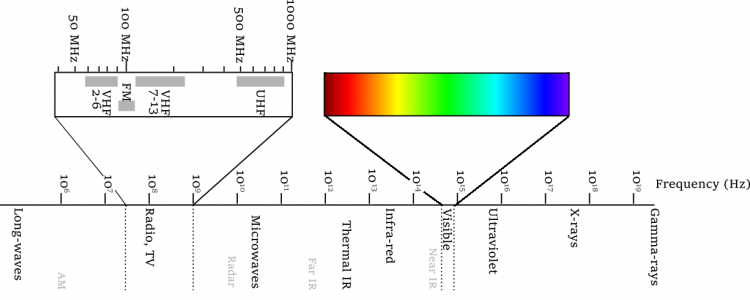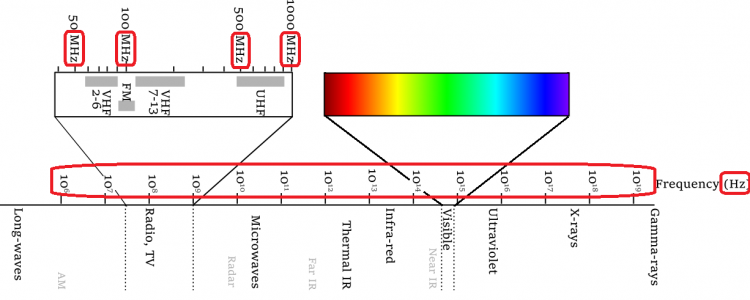This is an old revision of the document!
Table of Contents
Intro to Radio Waves
Before we can start discussing Amateur Radio (or Ham Radio), we need to talk a little bit about radio waves. We'll explore this topic in much more detail later on, but for now, let's look at some foundational concepts.
Imagine the radio in your car could not only listen but also transmit on any frequency you like. What would happen as you move up and down the dial?1)

Starting in the FM radio range, let's turn the dial down:
- At 88.1 MHz, you'd be transmitting on top of CBC Radio 1 FM (in the Vancouver area).
- At 0.690 MHz (or 690 kHz) you'd be transmitting on top of CBC Radio 1 AM (in the Vancouver area).
- Around 1 kHz (or 1000 Hz) you'd be interfering with military submarine radio communications.
At this point, you should start thinking about the relationship between MHz, kHz, and Hz. We'll add more to the list below.
There's a lot of stuff in between, but it's pretty much radio waves all the way down. However, turning the dial above the FM radio stations yields some surprises:
- At 2.4 GHz (or 2400 MHz) and 5 GHz (or 5000 Mhz), you'd be interfering with WiFi signals.
- Between 30 and 120 THz (30,000 and 120,000 GHz), you'd be in the mid-infrared range and your antenna would start to feel warm.
- At 400 THz, the antenna would start glowing red. By increasing the frequency, you'd go through all the colours of the rainbow until the last purple would vanish around 790 THz.
- Between 790 THz and 30 PHz (30,000 THz) you'd create UV rays, which are invisible but could blind you.
- Between 30 PHz and 30 EHz (30,000 PHz) you'd create X-rays, which we could be used to take pictures of your bones.
- And passed that you'd create gamma rays.
Electromagnetic Spectrum
So radio waves are a small part of what we call the Elecromagnetic Spectrum2), which also contains visible light and a lot of other invisible stuff:

Take a moment to look at the spectrum and see which terms you're not familiar with.
Let's now unpack some terms and symbols we just saw...
Hz
A Hertz (Hz) is a measure of how fast something vibrates. For example, the A-string of a guitar vibrates 440 times per second, so we say that it vibrates at 440 Hz. The next A (an octave higher) vibrates twice as fast at 880 Hz. The human ear can hear sounds between roughly 20 Hz and 20,000 Hz.3) With sound, the higher the frequency, the higher the pitch. With light, the higher the frequency, the “colder” the colour.
Electromagnetic (EM) waves and sound waves are completely different things. The only thing they have in common is that “something” oscillates, but many things oscillate so that's not saying much. Just seeing “Hz” doesn't tell you anything about what it is that's oscillating in the same way that seeing “°C” doesn't tell you anything about what it is that has temperature. “Hz” is a unit of measure, not a thing itself.
Now back to radio waves...
Without going into too much detail (yet), radio waves are created by oscillating electric currents. How many times this current oscillates per second is called the frequency, which is measured in Hz (or kHz, MHz, GHz).
The “k” (kilo), “M” (mega), or “G” (giga) that you'll often see in front of Hz is a quick way of multiplying by 1000:
| 1 kHz | = 1000 Hz | = 103 Hz (1 followed by 3 zeros) | |
| 1 MHz | = 1000 kHz | = 1,000,000 Hz | = 106 Hz (1 followed by 6 zeros) |
| 1 GHz | = 1000 MHz | = 1,000,000,000 Hz | = 109 Hz (1 followed by 9 zeros) |
These prefixes are not only used for frequencies. You've seen them in other places before:
- 1 km (kilometer) = 1000 m (meter)
- 1 MW (megawatt) = 1,000,000 W (watt)
- 1 GB (gigabyte) = 1,000,000,000 B (byte)
So no matter what the unit of measure, these prefixes mean:
- kilo (k) = a thousand
- mega (M) = a million
- giga (G) = a billion
- tera (T) = a trillion
This might be a good time to mention that we also have prefixes for small units (more on this later):
- milli (m) = a thousandth
- micro (μ) = a millionth
- nano (n) = a billionth
- pico (p) = a trillionth
Now, let's take another look at the Electromagnetic Spectrum picture. You should be able to make sense of pretty much all of it:

- FM radio and TV broadcasting is between 50 MHz and 1000 MHz (called VHF and UHF bands).
- But some radio waves go even lower than 106 Hz (or 1 MHz).
- Above radio waves are Microwaves, Infrared, Visible light, UV, Xray, and Gamma-rays.
Now, let's look at where Ham radio frequencies are on that spectrum.
Ham Bands Overview
Ham radio operators are allowed to transmit on very specific slices of the Electromagnetic Spectrum depending on which qualifications we have (“Basic” or “Basic +”):
- In green are VHF, UHF, SHF, and EHF bands that require only the Basic qualification.
- In orange are LF, MF, and HF bands that require Basic with Honours, Basic with Morse, or Basic with Advanced qualification.
- In blue are CB bands, which don't require any qualification but can only be used with unmodified CB radios at relatively low power (for reference).
- In red are the AM and FM radio broadcasting bands (for reference).
- In maroon are VHF and UHF TV channels (for reference).
Bandwidth
Although the human ear can detect sounds between 20 Hz and 20 kHz, human speech typically uses sounds between 300 Hz and 3000 Hz. Modulating these sounds (more on that later) onto a radio wave means that the radio will actually transmit over a range of frequencies that we call bandwidth. For example, using SSB, the bandwidth would be 2700 Hz (300 Hz to 3000 Hz). So a radio tuned to transmit at 3.800 MHz would actually transmit between 3.7973 MHz and 3.7997 Mhz. Using AM, the bandwidth would be 6 kHz so the transmitted frequencies would be between 3.797 MHz and 3.803 MHz.
We'll explore this in much more detail later, but for now, the important concept is that to transmit a signal, the radio must transmit over a range of frequencies, not just one single frequency. This range is called bandwidth.
In addition to only being allowed to transmit on specific frequencies, ham operators also have to make sure that they don't transmit over a greater bandwidth than allowed for the specific frequencies. That is, there are restrictions on where we transmit on the spectrum as well as how wide the transmissions are.
This is important because different modes have different bandwidth requirements. From lowest to highest:
| Mode |
|---|

